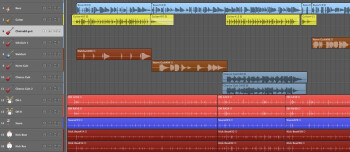This time I invite you to review the current state of your drums recordings. And I'll begin with a consideration that goes beyond the instrument at hand...
I can’t get enough…
As you have probably realized, the drum kit is the most complex instrument we have seen so far in this series. The diverse timbres of its different elements, the sound field that needs to be transcribed, as well as the dynamic range to cover often require the use of several microphones, depending on the goals you wish to achieve. But don’t forget that the more mics there are capturing the same source, the harder it can be to handle phase issues. This is something you have already had to deal with when recording the snare and kick, so it shouldn’t come as a surprise that you need to consider these issues when mixing all the different tracks: Mono Room, Overheads, Kick(s), Snare(s), etc. Consequently, even if some people won’t agree with me on this, I strongly recommend you to limit the number of mics to the minimum possible. If you stick to the strictly necessary to get the sound you want, it will be easier to achieve your goals.
But then again, nothing stops you from surrounding your kit with microphones. However, I think this approach will only make you have to deal with a bigger issue later on. I sometimes actually ask myself whether there will come a time when we will give the listeners all the tracks for them to mix them as they wish, just to avoid having to make decisions during production… But that’s not how I see music, call me “old school” if you like.
To cut it short, the way I see it is less is more. To me, economy of means goes hand in hand with effectiveness. And after all, isn’t this what makes the job of an audio engineer so creative?
But I’m digressing here…
Rough mix
Up to now we have used no less than 9 mics. That’s quite a lot! And yet, we are not done yet… But then, what is the goal of this article which starts with an apology of minimalism from the first paragraph? Well, simply to try to make you understand that with these nine tracks you might have a lot more information than what you can handle…or not enough. It all depends on what you are looking for. For instance, if the song you are mixing has a very deep bass line, what good will a Kick Sub mic be? If you’re producing something classic (think early Beatles), what’s the point of having a pair of overhead mics? And, on the contrary, if your toms are very important for the groove of the song, wouldn’t you be missing something?
However, since we work outside of a real musical context for this series, in the coming weeks we’ll see other sound recording techniques, but that doesn’t mean that you have to apply them all at the same time!
Look at what we’ve achieved so far:

- 01 Kit min Verse 00:14
- 02 Kit min Chorus 00:28
- 03 Kit Verse 00:14
- 04 Kit Chorus 00:28
The first two clips use the Mono Room, Overheads, Snare Top, and Kick Out tracks, plus the RE20 from last week. For the next clips, the RE20 is replaced by the Snare Bottom and Kick In. As you can hear there’s no reason to blush about. The results are pretty decent and they haven’t been processed at all! I only played with the levels of the tracks. And this is only one possibility among many others! I invite you revisit the previous articles and recover the raw tracks, so you can make your own mix, obviously taking into consideration the phase issues I mentioned above. There’s plenty to entertain yourself, isn’t there? Don’t hesitate muting some tracks if they don’t contribute anything to the sound you want to achieve. And if you think there’s still something missing, you will have to wait a couple of weeks until you find something that pleases you in the upcoming articles.
Finally, I guess you’ve noticed several things listening to these rough mixes. First, the Overheads are panned hard left and right, because I was looking for a relatively large result but you could always decide something else and narrow their scope. Second, I placed the snare’s close miking tracks according to the overheads, because if I had wanted the snare pinned to the center of the mix I would’ve used the ORTF technique for the overheads right from the start. Lastly, the drum kit is mixed from the point of view of the “audience, ” in other words, the snare and hi-hat are on the right. Is this the right thing to do? That’s something for the next article…
Download the audio files (in WAV format)



